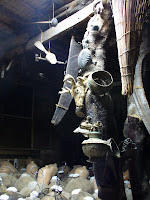October, in Lima, is devoted to the Señor de los Milagros - the Lord of Miracles. The Señor de los Milagros is a painting of Jesus on the cross painted by Angolan slaves on a wall that was later the only one to survive the devastating quake of 1655. The image was later credited with doing away with a caretaker's tumor, and with having resisted efforts by the Church hierarchy to have it painted over -several hired painters were physically unable to carry out their orders.
Since then, has been viewed as being imbued with the Holy Spirit and in 1715 the depiction of Christ was declared the patron and protector of Lima and christened the "The Lord of Miracles." In October1867, and every October since, a reproduction of the painting -which itself now resides in the Las Nazarenas church- was taken out in a several day-long processional through downtown Lima. In honor of the Señor de los Milagros people and institutions drape themselves in purple cloth, giving October the nickname of the "Purple Month."
October has traditionally also been given over to the confection and consumption of special sweets and foods prepared specially for that time of year. The most traditional and perennial favorite among these is turrón de Doña Pepa. There are numerous versions of turrones throughout the Americas and Europe, some are nougaty others chocolate-based. Lima's Turrón de Doña Pepa is composed of several layers of lightly anis flavored shortbread sticks held together with syrup made from raw sugar and spices, and garnished with candies. Older, more traditional varieties also include candied fruits in the toppings. No one knows with certainty who Doña Pepa was or why her name is associated with the pastry.
It used to be that one had to wait until October to sample Turrón de Doña Pepa, but in the 1980s it started to be available all year round. The place where we knew to get it was at a shop called Aurelia in Lince. Whenever we travelled to Lima, our grandmother would send us back to the States with a kilo or so of Aurelia turrón. In the 1990s, sadly, Aurelia closed after the partnership split up, but today turrón can be found in all of Lima's major grocery stores, though it is usually substandard. A better option is to seek out one of the shops set up by the major and reputable manufacturers of the stuff, like San Jose. If you do, be sure to sample a variety, from the oldest types, with candied figs, to the newer ones flavored with orange rind and other fruits.
Just thinking about it makes me wish I were there.
Just thinking about it makes me wish I were there.




















































